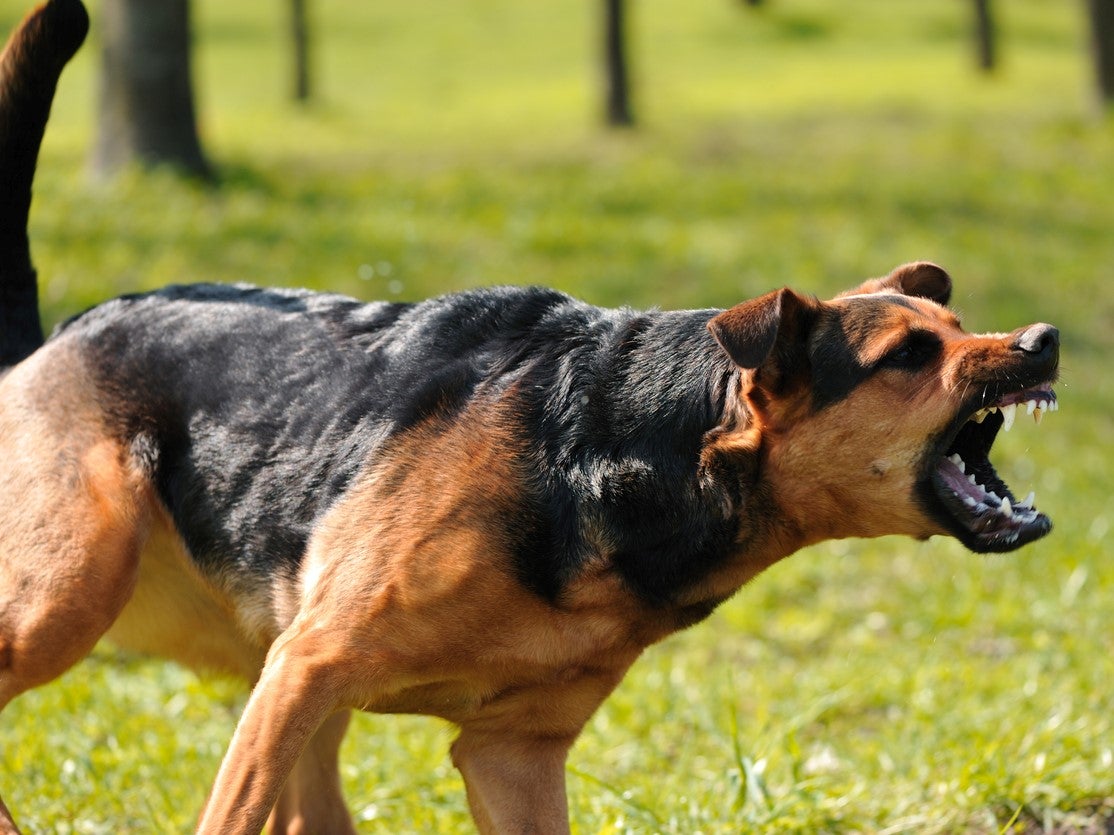‘Its jaws locked onto me’: How dog attacks became Britain’s unrecognised public health crisis
Canine attacks, including fatal incidents, are rising. But why - and what exactly should be done about them - are much debated issues

Even two decades on, Georgia Wood-Lee still remembers with unerring clarity the day a dog attacked her. She still has the scars.
She was 20 and had just started working in a pub near Wrexham. The landlord had asked her to come upstairs to meet Bruno, the German shepherd that lived there.
As she ascended the steps, the six stone animal was already on the landing above. It was growling and straining at a leash the landlady was struggling to hold.
“I made an immediate decision it wasn’t a good idea,” remembers Wood-Lee today. “I was turning to go downstairs when it lunged for me. The speed and power – it’s astonishing. Its jaws were locked on my arm before I even realised what was going on.”
In the panicked, bloody few seconds that followed, the landlord and landlady somehow managed to wrestle the animal off her. Wood-Lee staggered downstairs, her arm punctured and covered in blood. So traumatised was she that for a period she debated abandoning the dream career she had just started out on: as a veterinary nurse.
“I wasn’t sure I could be around dogs like that again,” the 40-year-old says. “It’s a very primal thing, an animal attacking you. It stays with you.”
That was 2002. Some 3,395 people were hospitalised by such incidents that year.
By 2018 that figure had skyrocketed to 8,389. Numbers in the four years since are sketchy but the limited evidence suggests that, even taking into account an uptick in pet ownership during the pandemic, the upward trend has only got steeper.
Dog attacks, in short, are rising fast across the UK.
Fatal incidents, too, are following a similar trajectory. In the decade up to the 1991 Dangerous Dogs Act, 15 people were killed by canines according to the Office for National Statistics. By contrast, in the 10 years up to 2022, there have been at least 32 such deaths.
The dangers, of course, should not be overstated. In a country of 12 million dogs, attacks remain thankfully rare. It barely needs saying that the benefits of such pets astronomically outweigh any risks. But neither, too, should the growing rate of incidents be minimised, experts say.
“There can be this tendency to brush off [dog bites] as almost cartoon-ish,” says Dr Carri Westgarth, a lecturer in Human-Animal Interaction at University of Liverpool and author of The Happy Dog Owner. “But the physical and mental effects can be absolutely catastrophic for those involved. The fact that almost 9,000 people are being admitted to hospital every year means we absolutely need to be calling this what it is, which is an unrecognised public health crisis.”

As a phenomenon, this rise is causing more than just personal devastation.
Dealing with dog bites cost the NHS just shy of £71 million in the financial year 2017-18, while thousands of survivors are known to suffer trauma long after the event. In the case of children, almost 75 per cent of bites are to the head. A small but significant proportion are left scarred for life. Royal Mail, meanwhile, counts dog attacks as one of the single biggest reasons why staff quit. Five of their workers were bitten every single day in 2020-21. The consequences for the animals aren’t great either: serious incidents, the RSPCA points out, can lead to the destruction of creatures often guilty of no greater crime than being momentarily anxious and reacting instinctively.
Yet what exactly is causing this explosion – as well as how to deal with it – remains a contested issue.
“To be honest, we're not sure why this is happening,” says Dr John Tulloch, an epidemiologist and vet also at the University of Liverpool whose 2021 research paper first truly highlighted how significant the increase was. “One of the big asks that comes from the research is that we basically need to do more to understand how and why more people are being attacked.”
Possible explanations include societal changes – there are more delivery drivers now, which may be leading to more incidents – and the growth in dogs being bought online from oft-unregulated, oft-overseas sources.
More intriguingly, perhaps, Tulloch reckons the way people interact with animals may have changed over the last two decades – partially as a result of social media.
“We very much anthropomorphize our relationship with dogs these days,” he says. “You see people on Twitter or TikTok literally calling them their children, and I think we're not necessarily always listening to what dogs are trying to tell us anymore. So, you'll see like a video of a dog smiling – and that dog isn’t smiling. It’s baring its teeth because it’s stressed. And when dogs get stressed, that’s when they bite.”
One quirk of his data shows that, while children under nine still accounted for the largest number of victims, it is attacks on adults that are rising most significantly. “It may be that we’re sort of forgetting what we were taught as kids about understanding dogs,” he concludes.
Counter-intuitively, perhaps, some experts suggest the Dangerous Dogs Act itself – introduced after a series of attacks in the Eighties – may be compounding the problem. By blanket banning four specific breeds – Pit Bull Terrier, Japanese Tosa, Dogo Argentino and Fila Brasileiro – the legislation may have created a general complacency that all other dogs are safe.
“It has the potential to lead to the public thinking that only those four are dangerous and that any other dog is safe,” says Dr Sam Gains, head of companion animals, science and policy with the RSCPA. “So there becomes this perception that any other type of dog is friendly which then leads to situations where people engage in high-risk behaviour without realising that any dog, if they feel stressed or frightened, has the potential to be aggressive.”
It was a point made, bluntly, in a 2019 parliamentary report on the subject. “Some legal breeds can pose just as great a risk to public safety as illegal breeds,” it stated. “Yet there are no legislative restrictions on their ownership. This inconsistency undermines the logic of the entire act.”

The solution, the RSPCA says, is a “full reform and consolidation of legislation”.
In effect, it would like to see the breed ban entirely scrapped – it says there is no statistical evidence those dogs are more dangerous – and powers for early and targeted intervention beefed up for where potential issues are identified.
“At the moment there’s lots of different pieces of legislation that relates to dog control, which are confusing and ineffective,” says Gains. “What we want to see is everything under one single dog control act that creates the scope for specialist teams to work at education, prevention and intervention.”
A mandatory dog ownership licence could, the charity argues, help fund those measures. Where such a scheme has been implemented in the Canadian city of Calgary, it has been widely considered a success and driven down bite rates, says Gains - although others have pointed out that such a financial outlay would hit the poorest the hardest.
The government, for its part, has offered no suggestion it might consider a change in legislation any time soon.
Yet, to some extent, such a solution perhaps misses one key factor anyway.
“We have this idea that all dog attacks happen because the owners are irresponsible or their victims are to blame in some way,” says Westgarth again. “That misses the point. The one thing I hear most from owners when dealing with bites is: ‘But they’ve never done anything like this before!’ Well, they have now.”
Something similar, she points out, is often said in the aftermath of fatal attacks. “Sometimes it emerges the dog has already displayed this behaviour before,” she says. “But equally sometimes, it comes out of nowhere.”
Owner education and legislation must, of course, play a part in driving down attack numbers, she reckons, but more creative thinking is also be needed.
“Look at medicine bottles,” says Westgarth, who has been canine-lover all her life despite being bitten on the head as a toddler. “They’ve been created so they are safe if they accidentally get left with a child or you have airbags in cars in case you crash. In the same, we need to think of ways we can create a world where we reduce the risk of dog attacks.”
The example, she gives, is of homes having external letter and parcel boxes installed as standard at homes to prevent post men and women having to enter gardens. Fenced off playground area – increasingly common anyway – would be another.
“Dogs are such a wonderful part of human life – they bring us so many benefits,” she says. “But we absolutely must not dismiss or play down the dangers they can bring.”
Join our commenting forum
Join thought-provoking conversations, follow other Independent readers and see their replies
Comments
Bookmark popover
Removed from bookmarks